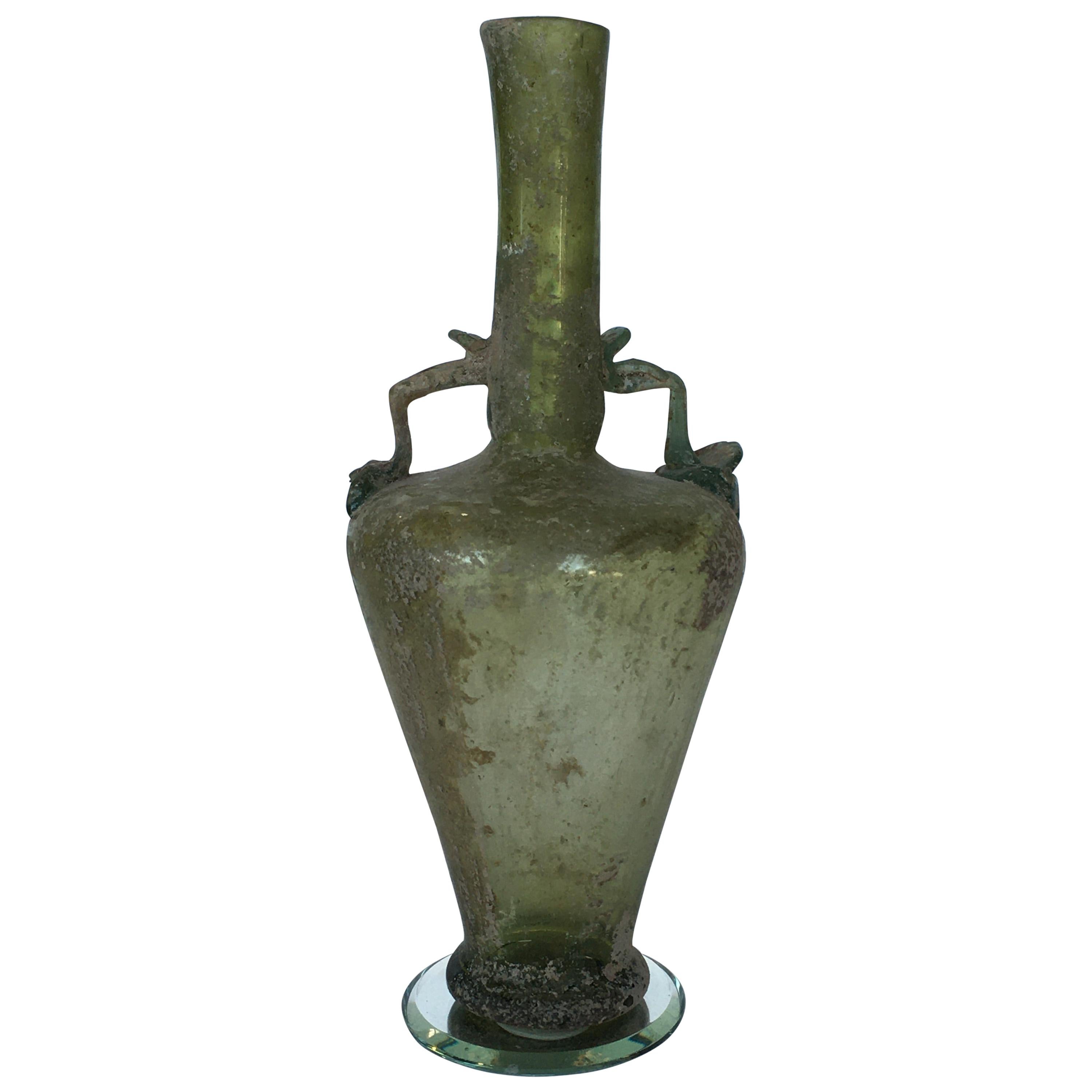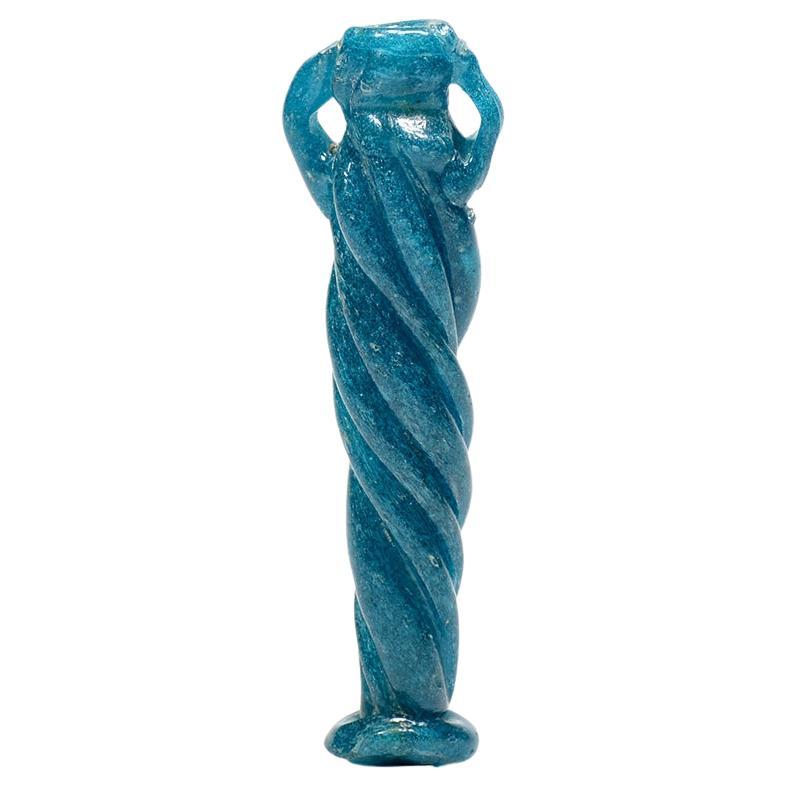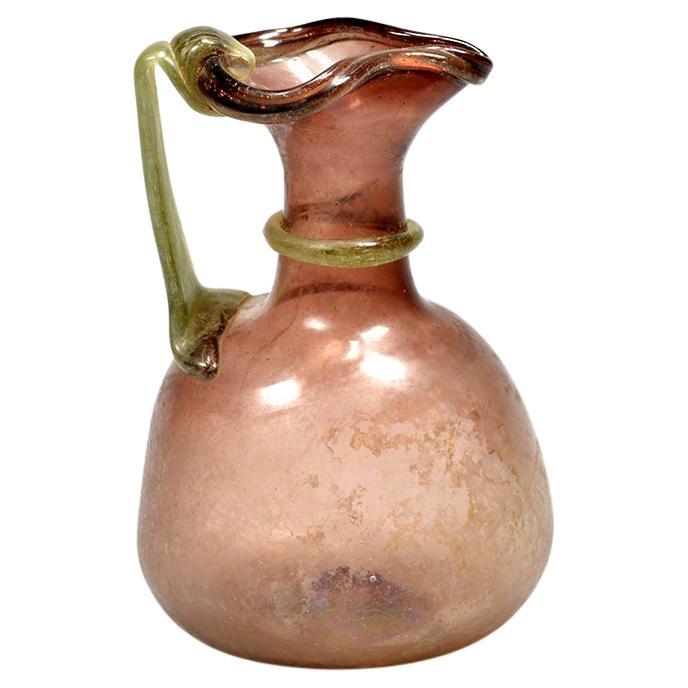Want more images or videos?
Request additional images or videos from the seller
1 of 8
Ancient Roman Turquoise Glass Cup
About the Item
Turquoise glass cup
Roman Empire, circa 3rd-4th century A.D.
With old label reading ‘’965’’.
“Pliny relates that the art of glass-making [.] was actually discovered under the reign of Tiberius, and that the shop and tools of the artist were destroyed, lest, by the establishment of this invention, gold and silver should lose their value.”
Suetonius Tranquillus, Life of Tiberius
This elegant piece of glassware was hand blown, with a gently flared lip and cone-shaped foot. Its maker, evidently an artisan of particular skill and patience, has achieved a beautiful semi-translucent turquoise hue across the cup, a fine example of the heights achieved in the glassmaking of the Roman Empire - a period of dynamic artistic development, ushered in by the advent of glass-blowing technology in the 1st Century A.D., which saw the emergence of a diverse range of styles and forms. Thanks to the quality of the pieces produced in the Roman workshops, these became one of the Empire’s most valued exports, with glasses such as this one traded far beyond the Mediterranean world, into Persia and India, and similar examples have even been discovered as far afield as Eastern China, unearthed in Han Dynasty burials from Guangzhou and Nanjing.
This piece comes from the collection of textile magnate Louis-Gabriel Bellon, who assembled one of the most important private collections of antiquities in nineteenth century France. Himself an archaeologist, trained by Auguste Terninck in 1874, he conducted numerous excavations, firstly in Saint-Nicolas-lez-Arras and later in Rouen, expanding his collection of antique glasses, vases, and bronzes. After a triumphant exhibition of terracotta figurines from Tanagra at the Paris World Fair in 1878, Bellon began showcasing his collection to the French public. In 1884, he exhibited in Rouen, at the Palace of the Consuls, where his collection was celebrated as the most impressive component of the show. As well as a collector and industrialist, Louis-Gabriel Bellon was a painter, and a close friend of the important proto-Impressionist artist, Camille Corot. After his death, Bellon’s son Paul (1844-1928) continued to expand his collection and transformed the family home in Saint-Nicolas into a private museum worthy of his father’s taste and vision.
Measures : Diameter: 9.2 cm
Height: 6.2 cm.
Provenance:
Collection of Louis-Gabriel Bellon (1819-1899), Saint-Nicolas-lez-Arras and Rouen
Thence by descent.
- Dimensions:Height: 2.45 in (6.2 cm)Diameter: 3.63 in (9.2 cm)
- Style:Classical Roman (Of the Period)
- Materials and Techniques:
- Place of Origin:
- Period:
- Date of Manufacture:circa 3rd-4th Century A.D.
- Condition:
- Seller Location:London, GB
- Reference Number:
About the Seller
5.0
Recognized Seller
These prestigious sellers are industry leaders and represent the highest echelon for item quality and design.
Established in 2008
1stDibs seller since 2014
100 sales on 1stDibs
Typical response time: 8 hours
Associations
LAPADA - The Association of Arts & Antiques DealersInternational Confederation of Art and Antique Dealers' AssociationsThe British Antique Dealers' Association
- ShippingRetrieving quote...Ships From: London, United Kingdom
- Return PolicyA return for this item may be initiated within 14 days of delivery.
More From This SellerView All
- Ancient Hellenistic Glass Finger RingLocated in London, GBThis beautifully preserved ring was cast from light green transparent glass. Its large size and shape are typical of Hellenistic finger rings, and its now ...Category
Antique 15th Century and Earlier Classical Greek Glass
MaterialsGlass
- Ancient Greek Black Glaze Kantharos Wine CupLocated in London, GBGreek Black Glaze Kantharos Circa Early 4th Century B.C. Terracotta With old label reading ‘No. 133’ Height: 8.8 cm This 4th Century B.C. kan...Category
Antique 15th Century and Earlier Classical Greek Vases
MaterialsCeramic
- Roman Marble FootLocated in London, GBRoman marble Fragment of a Right Foot with Sandal Circa 1st - 2nd Century A.D. An evocative Roman marble fragment, preserving the front portion of an over-lifesized sandalled foot. The toes, nails, and bridge of the foot have been sensitively carved. The outer sole of the sandal remains, with delicate, pointed straps joining between the first two toes in a diamond shape. This fragment once belonged to Danish sculptor Jens Adolf Jerichau...Category
Antique 15th Century and Earlier Italian Classical Roman Figurative Scul...
MaterialsMarble
- Roman Marble Head of SophoclesLocated in London, GBRoman Marble Head of Sophocles Circa 1st-2nd Century Marble This fine Roman marble head preserves the proper left side of the face of a middle-aged man, with broad nose, soft lips, and bearded chin. The short beard and sideburns have been finely carved with a flat chisel, to render the soft, wavy strands of hair. The cheekbone, undereye, and nasolabial folds have been delicately modelled in the marble by a skilled hand. In a letter from 1975, the former director of Ny Carlsberg Glyptotek, Copenhagen, suggested that the head could depict the Ancient Greek tragedian Sophocles. Few figures in the Classical world stand aside Sophocles (c. 496-406 BC), inarguably the best known of the Athenian tragedians, in terms of the impact his works have had on the history of art and literature. The psychological depth he achieves in the seven of the 123 of his plays that have survived to the present day - most notably the three Theban plays: Antigone, Oedipus the King, and Oedipus at Colonus - not only inspired the Athenians, among whom Sophocles was honoured as a hero long after his death, but in our own time, have provoked landmark works on phychoanalysis and literary criticism, by thinkers like René Girard and, most famously, Sigmund Freud. In its masterful treatment of the marble this fragment sensitively captures the features of one of the most important playwrights of all time. Height on stand: 7.9 inches (20 cm). Provenance: Collection of Danish sculptor Jens Adolf Jerichau...Category
Antique 15th Century and Earlier Classical Roman Busts
MaterialsMarble
- Roman Marble Statuette of JupiterLocated in London, GBRoman Marble Fragment of jupiter Circa 2nd-3rd Century A.D. Measure: Height: 19.7 cm This beautiful Roman fragmentary statuette depicts Jupiter, the king of the gods, here recognisable from his two chief attributes, the eagle with outstretched wings - according the Pseudo-Hyginus, singled out by Jupiter because ''it alone, men say, strives to fly straight into the rays of the rising sun'' - and the base of the scepter, which remains at the side of the left foot, an aspect likely borrowed from the statue of Zeus at Olympia, once one of the Seven Wonders of the World. Though much of the original piece has been lost, the subtle anatomical detail in the feet mark this out as a piece of exceptional quality, and the work of an artist of particular talent and patience - as Johann Winckelmann once said of the famous Belvedere Torso, ''if you contemplate this with a quiet eye [...] the god will at once become visible in this stone.'' This fragment once caught the eye of Henry Howard, 4th Earl of Carlisle (1694-1758), a Knight of the Garter and among the most prolific collectors of his day. The piece, acquired during his travels to Rome, was proudly displayed on an alcove of the Western Staircase of Castle Howard...Category
Antique 15th Century and Earlier Italian Classical Roman Figurative Scul...
MaterialsMarble
- Ancient Greek Corinthian HelmetLocated in London, GBCorinthian helmet with Bull Horns and Lotus Flower Decoration. Archaic Period, c.550-500 BC. Cast, hammered and incised bronze. An exceptionally well preserved example of one of the most iconic ancient Greek...Category
Antique 15th Century and Earlier European Classical Greek Mounted Objects
MaterialsBronze
You May Also Like
- Ancient Roman GlassLocated in Delray Beach, FLBeautiful original ancient Roman glass embedded in Lucite cube, was used for containing perfume. Exceptional object of art for display.Category
Antique 15th Century and Earlier Israeli Glass
MaterialsMurano Glass
- Ancient Roman Glass BottleLocated in Los Angeles, CAAncient Roman glass bottle with thin thumb handles, circa 2nd-3rd century AD. Origin Roman Empire.Category
Antique 15th Century and Earlier Italian Other Glass
MaterialsGlass
- A Late Roman turquoise glass rod-formed balsamariumLocated in UTRECHT, UTGlass balsamarium with a twisted tubular body, tapering towards the applied disc base, with two trailed handles 12.0 cm (h) Provenance: Ex anonymous Sale; Pierre Bergé Auctioneers, Paris, 17 January 2009, lot 38 Roman glass was used primarily for the production of vessels. It developed from Hellenistic technical traditions, initially concentrating on the production of intensely coloured cast glass...Category
Antique 15th Century and Earlier Italian Classical Roman Glass
MaterialsGlass
- A Roman purple glass jugLocated in UTRECHT, UTA jug with a bell-shaped body and clover lip, a green trailed handle and a green collar in the middle of the cylindrical neck. 12.4 cm (h) Intact Provenance: Ex C.A. Hessing Collection, coll. no.57 Ex Anonymous sale; Bonhams, London, 22 September 1998, lot 226 Published: Sheppard & Cooper Ltd, Glass: The Eighth Wonder of the Ancient World, London, 1994, p.14, no.75. Roman glass was used primarily for the production of vessels. It developed from Hellenistic technical traditions, initially concentrating on the production of intensely coloured cast glass vessels...Category
Antique 15th Century and Earlier Italian Classical Roman Glass
MaterialsGlass
- A Roman yellow glass unguentariumLocated in UTRECHT, UTBelly-shaped with cylindrical neck and with folded down collar rim, the unguentarium with twisted glass decoration with white intertwining the main yellow colour 4.5 cm (h) Intact Ex. German private collection H.G., collected between 1970s-1990s Roman glass was used primarily for the production of vessels. It developed from Hellenistic technical traditions, initially concentrating on the production of intensely coloured cast glass vessels...Category
Antique 15th Century and Earlier Italian Classical Roman Glass
MaterialsGlass
- Ancient Classical Style Antique Iridescent Glass BottleLocated in New York, NYLucite base holder, Measures. 3.4" x 4.2" x 1.8"L.Category
Antique Mid-18th Century Unknown Classical Roman Bottles
MaterialsBlown Glass
Recently Viewed
View AllMore Ways To Browse
Turquoise In Silver
Antique Glass Show
Antique Glass Cups
Art Glass Cup
Collection Cups
Ancient Roman Gold
Glass Gold Cup
Glass With Gold Cups
Measuring Cup Glass
Antique Roman Glass
Art Glass Glassware
French Empire Glass
Silver Measuring Cup
Antique Gold Cup
French Silver Cup
Roman Gold Glass
Cup Paris
Nineteenth Century Glass





